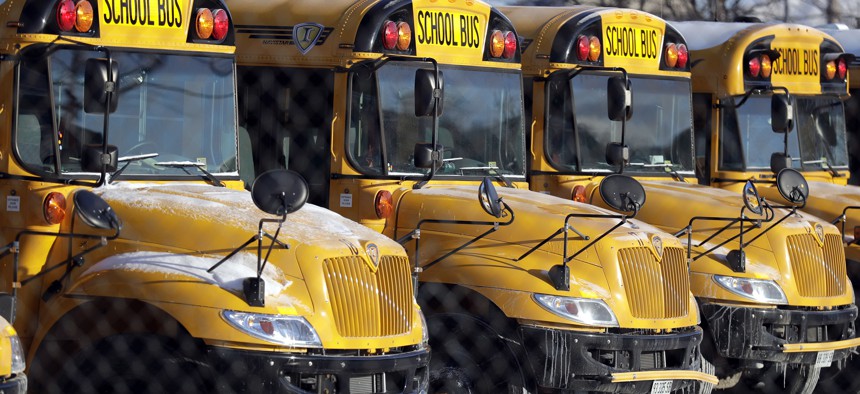The Whiter, Richer School District Right Next Door

AP Photo
Public schools’ dependence on local property taxes means some districts get isolated from the financial resources in their communities.
The Waterbury School District is quarantined within man-made, invisible walls, partitions that hug it on each side, forming taut, if unnatural, boundaries on the map. The school district, in Waterbury, Connecticut, is touched by eight other districts, each one whiter, more affluent, and receiving more dollars than Waterbury itself. Take the Wolcott School District, for example, where 87 percent of students are white, and which spends $2,000 more per student than Waterbury, which is 82 percent nonwhite; or the Plymouth School District, which has a racial makeup that’s comparable to Wolcott’s, and which spends $3,500 more per student. More wealth, more white students, more resources for those kids.
Waterbury is surrounded by what EdBuild, a nonprofit focused on equity in school funding, calls an isolating border; the group defines an isolating border as one that divides one school district from another that is at least 25 percent whiter and receives at least 10 percent more funding per student. What’s happening in Waterbury is not unique. Across the United States, in 42 states, there are 969 of these isolating borders, according to EdBuild’s recently released report. The average disparity in funding along these borders was roughly $4,000 per student. Waterbury, the group found, is the most isolated school district in the country.
Waterbury’s predicament points to an unstable aspect of the public-education system in the United States: The foundation of its funding comes from local property taxes. As a report from the Lincoln Institute of Land Policy shows, roughly 36 percent of K–12 funding comes from these taxes. That means inequality is often baked into district lines; wealthier communities will have more money to spend on their students. It’s an often mentioned but under-discussed problem, particularly among the 2020 Democratic presidential candidates.
In May, Senator Kamala Harris of California took aim at the disparity. “It is completely upside down that we currently have a system where the funding of a school district is based on the tax base of that community,” she said during a town hall with the American Federation of Teachers. In March, it was Senator Elizabeth Warren of Massachusetts who wanted to take a more national approach to fixing it. “We’ve gotta use our federal education laws to help supplement [local funding] so we can get real money into our public schools K–12,” Warren said. And as part of his Thurgood Marshall Plan for Public Education, the campaign of Senator Bernie Sanders of Vermont writes that he will “rethink the link between property taxes and education funding.”
Rethinking that link is important, Rebecca Sibilia, the executive director of EdBuild, told me, because micro-districting—the term for what is happening in Waterbury and elsewhere—handcuffs some of the tools the government might use to desegregate schools. In 1974, in the Supreme Court case Milliken v. Bradley, the justices ruled that desegregation plans could not leapfrog school-district borders. That means the federal government could shuffle children between schools only in the same district in places like Waterbury. Interestingly, even as Democrats argued over the utility of busing as a method of desegregation during the first two rounds of debates, school funding only tangentially came up as a remedy. “We are still upholding a school system that is separate and unequal,” Sibilia told me.
A browse through other 2020 Democratic contenders’ websites does not turn up much when it comes to addressing the link between property taxes and public schools. And when I reached out to several campaigns—including those of Harris, Sanders, Warren, former Vice President Joe Biden, Senator Cory Booker of New Jersey, former Housing and Urban Development Secretary Julián Castro, and South Bend, Indiana, Mayor Pete Buttigieg—only Castro’s campaign responded with details about how he might address the gap. A spokesman for his campaign told me that his education plan would provide “full Title I funding that would direct federal investment into low-income and high-poverty communities that are often [under-resourced] at the local level, often as a consequence of how property taxes are structured.”
Several candidates, for their part, have argued for increased funding for Title I, which provides federal grants aimed at helping students in low-income schools. But putting more money into Title I doesn’t fundamentally reform the funding disparities; school districts that are able to raise significant money from property taxes could still have an advantage.
Sibilia offered a possible solution. States could address the funding disparity by tweaking how property taxes are distributed. Perhaps all property taxes could get pooled within a county and then evenly distributed across districts—after all, there are about 4.5 times as many school districts in the country than there are counties. Or maybe the tax dollars could be pooled statewide; then, regardless of where students lived in that state, they would receive the same amount of resources for their education. The federal government, she said, could incentivize states to pursue these tweaks with funding matches. It might be a long shot, but it could work.
The Democratic presidential debates, when they have turned to education, have so far focused on busing, college affordability, and school safety. Senator Michael Bennet of Colorado, notably, veered away from busing to talk about modern segregation during the second slate of debates, but only for a moment. But the schools trapped within these isolating, segregating borders will require more sweeping solutions to break free of them.
Adam Harris is a staff writer at The Atlantic.
NEXT STORY: Almost Half of State Supreme Courts Have Only White Judges, Report Finds





